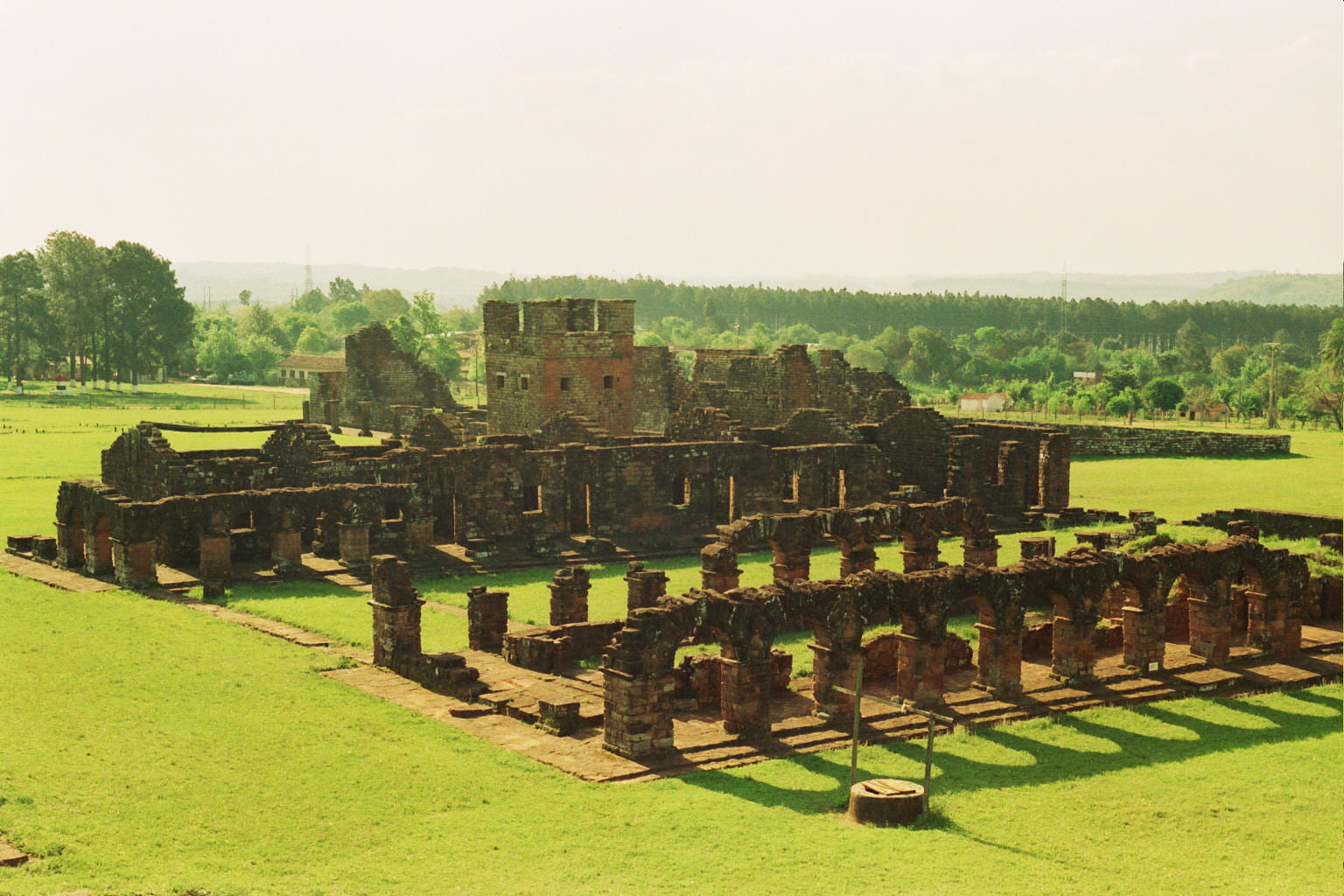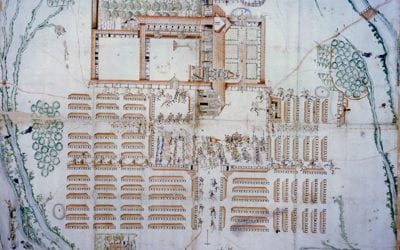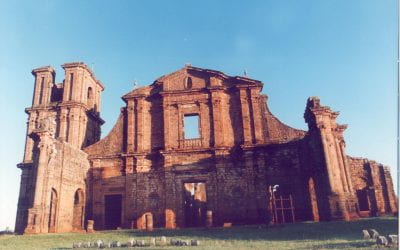Imagining Guaranis and Jesuits
Yesterday’s History, Today’s Perspective
Beginning in 1610, Jesuits founded a series of towns for indigenous peoples in the southern region of America. These towns, known as “missions” or “reductions,” achieved enormous territorial, demographic and political importance. In the first decades of the 18th century, Paraguay’s thirty missions became home to 140,000 indigenous residents. They spoke the Guarani language for the most part, and it became the basic means for conversion to the Christian faith.
Each reduction had two Jesuits, a priest and his companion, in charge of spiritual and “temporal” administration, helped by an indigenous elite who performed administrative and ecclesiastical jobs. These people could read and write in Guarani, Spanish and Latin. The priests strictly supervised all daily tasks, making sure that the natives fulfilled their obligations of attending mass and working in the farms, fields and ranches, which provided the basic goods for all the towns: corn, yucca, cotton, yerba mate and meat. Other activities also took place in mission workshops, where most of the sculpture and ornaments for churches were created. Music too entered the lives of indigenous people in the missions; they both copied musical scores and manufactured several types of musical instruments. In one of the mission churches, Santísima Trinidad, a well-preserved frieze depicts angel musicians playing harp, violin, trumpet, claves and even maracas. We can only imagine the unique sounds that combined the music brought from Europe with the resonant elements of the earth.
In spite of their apparent success, the reductions were afflicted time and time again by epidemics and devastating conflicts that decimated the population. Outbreaks of smallpox, measles and fevers constantly plagued the communities, causing many deaths. During all of the 17th century, slave-hunting adventurers from São Paulo conducted raids to capture native peoples from the missions, causing the early destruction of many of these towns.
Religious expression was the chosen means to overcome the traumatic effects of these crises, and Jesuit teachings emphasized Christian forms of native devotions such as the cult of the Archangel Michael and the Virgin Mary. The Jesuits varied in their attitudes toward unorthodox indigenous religious expressions, sometimes rejecting such modes of worship and at other times assimilating them. Sometimes they promoted the incorporation of local visual and aural elements into the dominant Christian practice, ranging from church decorations to the celebrations of the liturgical calendar. Although the history of this experiment ended abruptly with the expulsion of the Jesuits from all Spanish and Portuguese territories in 1767, the native peoples maintained their system of government in the missions and continued their devotional practices, at least until the civil wars that engulfed the region from 1810 on.
Throughout the last three hundred years, historical literature and fiction have found a frequent theme in the missions. The Jesuits spread news about this distant corner of the American colonies through the European continent and provided valuable information about the natives with whom they had had contact. Reacting to this information, the European public soon developed highly polarized opinions. While apologetic stances defended the missions as a noble experiment of civilizing the indigenous people who resided in the forest, the anti-Jesuit position perceived the religious order as exploiters of the natives who sought to create a kingdom independent from the Spanish and Portuguese crowns. The first stance was represented in the numerous letters and chronicles written by the Jesuits themselves and by a non-Jesuit book expressing great admiration for the Jesuit experience: Il cristianesimo felice (Happy Christianity, 1743) by Italian author Ludovico Muratori. Indeed, Jesuits exiled to Italy continued the defense of the missions long after the order had been expelled from the Americas. José Manuel Peramás, one of these Jesuits, wrote a striking text, La República de Platón y los guaraníes (Plato’s Republic and the Guaranis), in which he compared the virtues of the mission organization with the tenets of government established by the classic teacher of ancient times. Even anti-Jesuit authors such as Montesquieu and Voltaire would not begrudge praise for the Jesuit rule in the South American forests as a perfect expression of good government.
The ample 18th-century literature also included many anti-Jesuit voices that began to impose in Bourbon Europe a decided opposition to the power that the Jesuits had acquired in the previous centuries. The Marquis of Pombal in the case of Portugal and Count Pedro Rodríguez de Campomanes in the case of Spain were among the order’s most vociferous opponents. Both insisted that ambitious Jesuits were dangerously creating a state within a state, a flagrant threat to the Iberian crowns. Their opinions were heavily influenced by a renegade former Jesuit, Bernardo Ibáñez de Echavarri, author of El Reino Jesuítico (The Jesuit Kingdom, 1762), a book almost simultaneously published in Spanish and Portuguese. The author argues that the Jesuits had created an independent political organization among the Guaranis that had the Iberian crowns as its target. In the same period, a rumor was spread that in Jesuit Paraguay, a king called Nicholas I had been anointed with his image on coins especially minted to circulate throughout the region. Although the Jesuits systematically denied the allegations, a well-known cacique, Nicolás Ñeenguirú from Concepción mission, who had a decisive role in the so-called guerra guaranítica (Guarani War), was suspected of being Nicholas I. The cause of the war was the border treaty of 1750, in which the Spanish and Portuguese crowns agreed that part of the mission territory would now fall under Portuguese rule. The Guaranis rose up in arms to protest this decision and prevent the treaty from being implemented. Armed confrontations between the Guarani militia and the Portuguese-Spanish troops continued during 1754 and 1756, ending with the defeat of the Guarani after many deaths. This war spurred the enmity of the Iberian crowns against the Jesuits, who were accused of instigating the natives to resist the decisions of the monarchies.
Disputes about the nature of the governance of the missions continued during the 19th century. Various proponents of the romantic movements vindicated the Jesuits as creating a utopian society that Europeans ought to pursue as a model. For example, among German backers of the Jesuits was Eberhard Gothein, who published Der Christlichsoziale Staat der Jesuiten in Paraguay in 1887, comparing the Jesuit Guarani experience with the imagined utopia of Italian theologian Tommaso Campanella in his Civitas Solis. Years later, the reductions inspired the socialist ideas of Cunningham Graham, one of the founders of the Scottish Labour Party, who wrote the short book, A Vanished Arcadia, devoted entirely to the vindication of the Jesuits’ labor in Paraguay.
At the beginning of the 20th century, however, Leopoldo Lugones published El Imperio Jesuítico, a well-known book in clear opposition to the Jesuits and subsidized by the Argentine government.Some years before, Paraguayan intellectual Blas Garay wrote El comunismo de las Misiones de la Compañía de Jesús en Paraguay (Communism in the Jesuit Missions of Paraguay, 1897). The text grew out of a foreword that the author had written to the reissue of Historia de las misiones (The History of the Missions) by Jesuit Nicolás del Techo (written in 1687). With a harsh tone, Garay refers to the legacy of the missions as very negative in the history of the country. Years later, Maria Fassbinder, a German author, published Der Jesuitenstaat in Paraguay (The Jesuit State in Paraguay, 1926) and Fritz Hochwaelder, an Austrian author, wrote Das Heilige Experiment(The Holy Experiment, 1941), both of which supported the Jesuit endeavors. In the context of World War II, the Swiss author Clovis Lugon published La république communiste-chrétienne des Guaranis (1609-1768). In the 1980s, the debate opened up again with the film The Mission, which presented a benevolent portrait of the Jesuits and their evangelical work among the Guarani.
The cited examples illustrate the renewed interest in the missions over the course of the last century in which favorable apologies inevitably confront anti-Jesuit stances. Generally, the literature tends to conceive the missions as a “state,” “republic” or “empire,” from a political viewpoint, and as a “paradise,” or “utopia” from a religious or philosophical viewpoint. French philosopher Michel Foucault referred to the Guarani missions as a “heterotopia,” a place or space of otherness that does not fit in with a hegemonic concept and functions in accordance with its own logic.
If indeed the debates have been eloquent, the opposition of the opinions has tended to create an excessively simplified view of the internal situation of the missions over the course of time. The result has been to present missionary governance either as a beneficial and civilizing regime or an oppressive enslaving system. This narrow set of views has also impeded any analysis of indigenous participation and responses in the formation of the missions. The indigenous population was considered as homogenous and passive in that process. The European debate about the missions appears, in this sense, very far from reality. Likewise, the insistence of the notion of a state in reference to the missions has tended to isolate them from the regional context in which they operated. In effect, the missions participated in a network of circulation of people and consumer goods in the River Plate region. Various Jesuit establishments traded products like yerba mate and leather hides throughout the entire region and had considerable influence in the policies of the colonial authorities. In turn, the Guarani natives participated in regional militia and helped the authorities in Buenos Aires and Asunción in different economic activities and in defense of the territory.
The missions constituted an “imagined community” that over the course of 150 years incorporated very diverse populations that had to adapt to a single pattern of spatial and temporal organization. That meant that the people had to adjust to new technologies, ranging from those directly linked to the construction of buildings and food storage to that of writing or map-making, that did not previously exist in indigenous contexts. The introduction of a routine life in which attendance at church alternated with farm work clearly was a radical break from the traditional indigenous forms of organization of time and space. The process of transformation of the indigenous way of life was slow and prolonged, and the attitudes of the indigenous people toward the colonizers varied. Initially, many political leaders and shamans energetically resisted evangelization. Later, they devised strategies to negotiate their entrance into the missions and participated directly in the governance of the communities through institutions such as cabildos (administrative councils) and militias. In the political and economic circumstances that affected the region of Paraguay and the Plate River, the missions gradually transformed themselves into a space of refuge for much of the indigenous population and thus served as a vehicle to reconstitute social and political ties and recreate native forms of religious identity. Although the mission residents could no longer practice their own religions as they used to, they adopted a type of Christianity sui generis, and they participated directly in the constant negotiations and readaptations that characterize the entire period.
Guaraníes y jesuitas en la imaginación histórica moderna
Por Guillermo Wilde
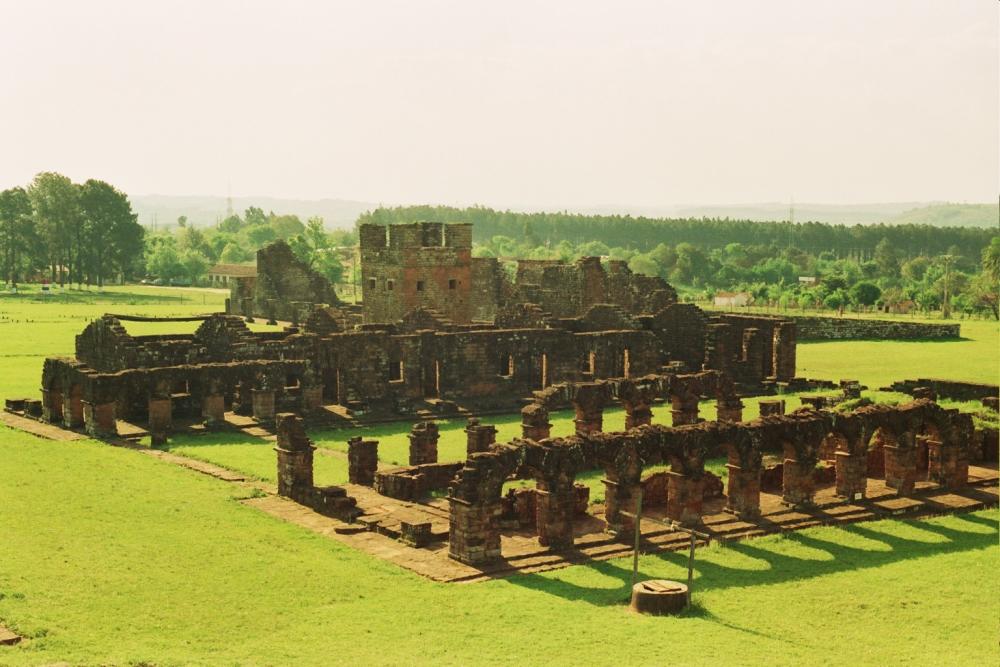
Ruinas de San Miguel Arcángel. Reconocidas como patrimonio de la humanidad por la UNESCO. Foto por Artur H.F. Barcelos .
Desde 1610, los jesuitas fundaron en la región meridional de América un conjunto de pueblos de indios, también conocidos como “misiones” o “reducciones”, que alcanzó enormes dimensiones territoriales, demográficas y políticas. En las primeras décadas del siglo XVIII, las 30 misiones del Paraguay albergaron una población total de 140.000 habitantes. Los indígenas allí congregados, hablaban mayoritariamente la lengua guaraní, que se convirtió en el medio básico de trasmisión de la fe cristiana. Cada reducción tenía dos jesuitas, un sacerdote y su compañero, encargados de la administración espiritual y “temporal”, ayudados por una elite indígena con cargos administrativos y eclesiásticos que sabía leer y escribir en guaraní, español y latín. Los sacerdotes supervisaban estrictamente las tareas cotidianas, controlando que los indígenas cumplieran con la asistencia a la misa y a los trabajos en las chacras, campos y estancias, de donde se obtenían los medios básicos de subsistencia de todos los pueblos: maíz, mandioca, algodón, yerba mate, carne. Dentro de las misiones también se desarrollaban actividades en talleres de oficios muy diversos, donde eran fabricadas la mayor parte de las esculturas y ornamentos para las iglesias. La actividad musical estuvo muy difundida en todas las misiones, donde no solo se escribían y copiaban partituras, sino que también se fabricaban instrumentos musicales de diferente tipo. En el templo de una de las misiones, Santísima Trinidad, se conserva hoy un friso representando ángeles músicos que tocan el arpa, el violín, la trompeta, el clave, y hasta las maracas. La contemplación del friso nos lleva a imaginar sonoridades singulares que mezclaban la música traída de Europa con elementos sonoros de la tierra.
A pesar de su éxito aparente, las reducciones fueron afectadas numerosas veces por epidemias y conflictos devastadores que redujeron la población de manera abrumadora. Brotes de viruelas, sarampión y fiebres las afectaron constantemente, ocasionando gran cantidad de muertes. Durante todo el siglo XVII, las tropas de esclavistas bandeirantes que provenían de la ciudad de Sao Paulo, realizaron expediciones de captura de indios misioneros, lo que ocasionó la destrucción temprana de varias misiones. Las expresiones religiosas constituyeron un medio privilegiado para superar los efectos traumáticos de estas crisis, y en este sentido se orientó la pedagogía jesuítica, con alusiones a formas cristianas de devoción nativa, como el culto al arcángel Miguel o la virgen Maria. También existieron expresiones religiosas heterodoxas elaboradas por los indígenas, frente a las cuales los jesuitas tuvieron actitudes variables, que oscilaron entre el rechazo y la adaptación. A veces los jesuitas promovieron la incorporación de elementos visuales y sonoros locales a las prácticas cristianas dominantes, desde la ornamentación de los templos hasta las celebraciones del calendario litúrgico. Aunque la historia de este experimento concluye abruptamente con la expulsión de los jesuitas de todos los dominios de la corona española, en 1767, los indígenas mantuvieron su sistema de gobierno en las misiones y continuaron con sus prácticas devocionales, al menos hasta la etapa de las guerras civiles que se inició en la región a partir de 1810.
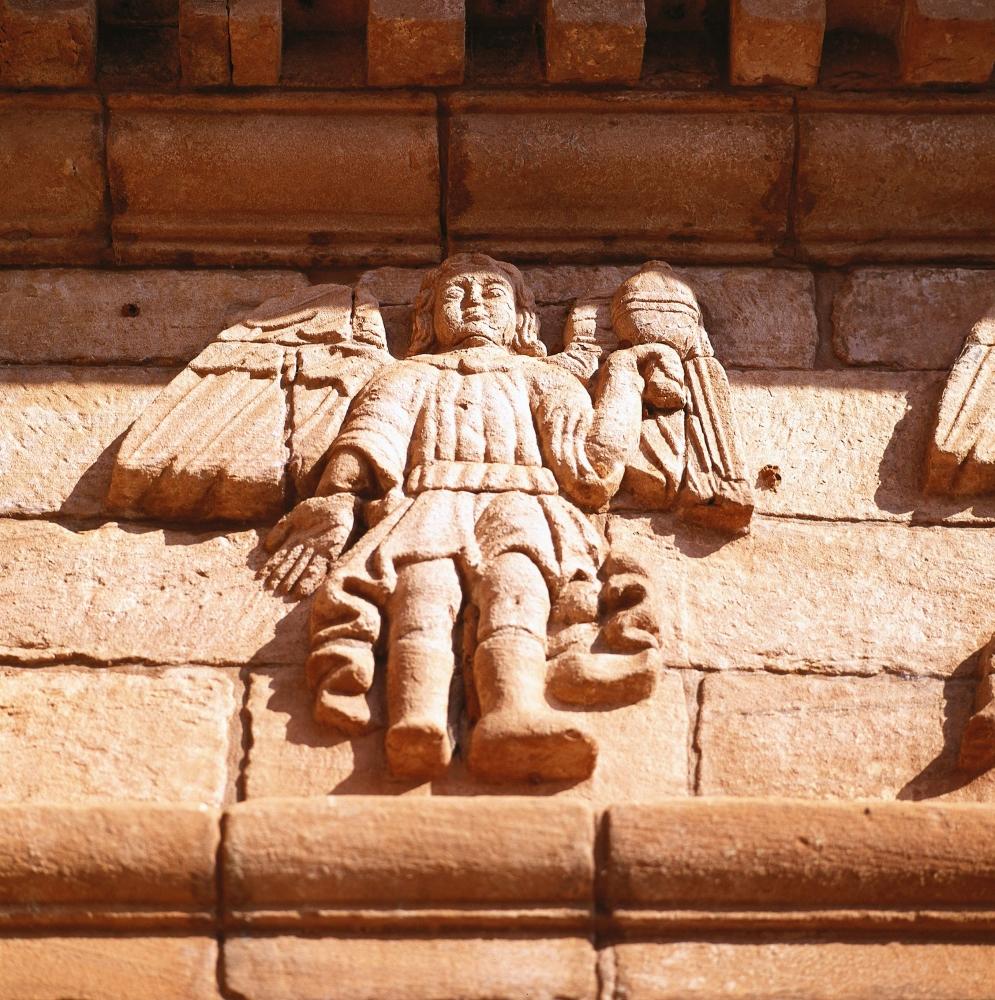
Ángel con maraca, un instrumento musical. Foto cortesía de Guillermo Wilde.
En los últimos tres siglos, las misiones aparecen como un tópico recurrente en la literatura histórica y de ficción. Los jesuitas difundieron por el suelo europeo numerosas noticias sobre aquel apartado rincón de los dominios coloniales americanos, brindando informaciones de gran valor sobre las sociedades nativas con las que entraron en contacto. En base a esas informaciones, el público europeo pronto polarizó sus opiniones. Mientras las posturas apologéticas defendieron a las misiones como un noble experimento de civilización de los indios que habitaban en la selva, las posturas antijesuitas vieron a los ignacianos como explotadores de los indios cuya intención era crear un reino independiente de las coronas ibéricas. La primera postura se encontró representada en numerosas cartas y crónicas sobre las misiones escritas por los mismos jesuitas, y la llamativa gravitación de una obra no jesuita, El cristianismo Feliz (1743), del italiano Ludovico Muratori, quien manifestó toda su admiración a la experiencia jesuítica. La defensa de las misiones continuaría incluso después de la expulsión de la orden, en manos de los mismos jesuitas exiliados en Italia. El jesuita expulso José Manuel Peramás escribió una llamativa obra llamada La República de Platón y los Guaraníes, en la que comparaba una a una las virtudes de la organización misional con las máximas de gobierno establecidas por el clásico maestro de la antigüedad. Incluso autores manifiestamente antijesuitas como Montesquieu o Voltaire, no ocultarían elogios al régimen de los jesuitas en las selvas sudamericanas como una expresión perfecta del buen gobierno.
La nutrida literatura del siglo XVIII también contó con exponentes del antijesuitismo, que comenzaron a imponerse en la Europa borbónica en clara oposición al poder que había adquirido la Compañía de Jesús en los siglos anteriores. Fueron ilustrados ibéricos como el Marqués de Pombal, en el caso de Portugal, o el secretario Rodríguez de Campomanes, en caso de España, los que con mayor fuerza atacaron a los jesuitas. Ambos insistieron sobre el peligro de las ambiciones jesuitas de creación de un estado dentro del estado, amenaza flagrante para las coronas ibéricas. En sus opiniones tuvo mucha influencia un ex jesuita renegado, Bernardo Ibañez de Echavarri, autor de El Reino Jesuítico(1762), obra que se publicó casi simultáneamente en español y portugués. Dicha obra sostenía abiertamente que los jesuitas habían creado una organización política independiente entre los guaraníes que atentaba contra las coronas ibéricas, y brindaba informaciones detalladas sobre el modo de gobierno jesuita. En la misma época, se difundió el rumor de que en el Paraguay jesuita se había ungido a un rey llamado Nicolas I, de quien se había plasmado una efigie en monedas especialmente acuñadas para circular por la región. Aunque los jesuitas lo negaron sistemáticamente, se sospechaba que el tal Nicolas I podría haber sido el conocido cacique Nicolás Ñeenguirú, de la misión de Concepción, quien había tenido una participación decisiva en el conflicto bélico llamada “guerra guaranítica”. En 1750 las coronas ibéricas habían firmado un Tratado de límites acordando que una parte del territorio de las misiones pasara al dominio de los portugueses. Frente a esta decisión, los guaraníes se alzaron en armas y resistieron a la ejecución del tratado. Los enfrentamientos armados entre las milicias guaraníes y el ejército luso-español se extendieron entre 1754 y 1756, concluyendo con la derrota de los guaraníes después de numerosas muertes. Este acontecimiento precipitó las opiniones negativas de las cortes hacia los jesuitas, que fueron acusados de instigar a los indios a resistir a las decisiones monárquicas.
En el siglo XIX continuaron las disputas en torno de la naturaleza del gobierno de las misiones. Diversos exponentes de los movimientos románticos las reivindicarían como realización de una sociedad utópica, de la que la sociedad europea debía seguir el ejemplo. Entre los alemanes deben mencionarse a Eberhard Gothein quien publica en 1887 Der Crhistlichsoziale Staat der Jesuiten in Paraguay tratando de confrontar la experiencia jesuítico guaraní con la utopía de Campanella. Años más tarde las reducciones fueron inspiradoras de las ideas socialistas del escocés Cunningham Graham, uno de los fundadores del partido laborista, quien escribió el opúsculo A Vanished Archadia íntegramente dedicado a reivindicar la labor de los jesuitas en el Paraguay.
Coincide con el inicio del siglo XX la publicación de la bien conocida obra de Leopoldo Lugones El Imperio Jesuítico, encargada por el gobierno argentino, y claramente opuesta a los jesuitas. Dos décadas más tarde, salió publicado un pequeño opúsculo del intelectual paraguayo Blas Garay titulado El comunismo de las Misiones de la Compañía de Jesús en Paraguay (1921). El texto se desprendía de una introducción que el autor había dedicado a la publicación, en 1897, de la Historia de las misiones, del jesuita Nicolás del Techo (escrita en 1687). Con tono severo Garay se refería a la herencia de las misiones de manera muy negativa en la historia del país. Años después el alemán Fassbinder publicó Der Jesuitenstaat in Paraguay (1926) y el austríaco Fritz Hochwaelder Das Heilige Experiment (1941). En el contexto de la segunda guerra el religioso suizo Clovis Lugon publicó su obra La république communiste-chrétienne des Guaranis (1609-1768). En los años ochenta el debate se reabrió con la película The Mission, en la que se presenta una imagen benevolente de los jesuitas y su trabajo evangélico entre los guaraníes.
Los ejemplos citados permiten constatar el interés renovado que las misiones suscitaron en los últimos siglos, donde se mantiene constante la contraposición entre posturas apologéticas y antijesuitas. En general, la literatura tendió a concebir a las misiones como un “Estado”, “República” o “Imperio”, desde un punto de vista político, y como un “paraíso”, o una “utopía”, desde un punto de vista religioso y filosófico. En algunos segmentos de su obra, Michel Foucault referiría a las misiones guaraníes como una “heterotopía”, un lugar o espacio de otredad que escapaba a la concepción hegemónica, y funcionaba de acuerdo a su propia lógica.
Si bien los debates han sido elocuentes, las posturas dicotómicas esbozadas arriba han tendido a crear una imagen excesivamente simplificada de la situación interna de las misiones a lo largo del tiempo. El resultado fue concebir al régimen misionero o bien como un beneficioso régimen civilizatorio o bien como un opresivo sistema esclavista. Esta visión también imposibilitó el análisis de la participación y respuestas indígenas en la formación de las misiones tendiendo. Por el contrario, la población indígena fue considerada como un sector homogéneo y pasivo en este proceso. El debate europeo sobre las misiones parece, en este sentido, muy alejado de la realidad concreta. Por otro lado, la insistencia en la noción de Estado para referir a las misiones, ha tendido a aislarlas del entorno regional en el que se desenvolvieron. En efecto, las misiones participaban de la red de circulación de personas y bienes de consumo en el espacio rioplatense. Los diferentes establecimientos jesuitas comerciaban productos como la yerba mate y los cueros en toda la región e influían en las políticas de las autoridades coloniales. Los indios guaraníes, a su vez, intervenían en las milicias regionales asistiendo a las autoridades de Buenos Aires y Asunción en diferentes actividades económicas y de defensa del territorio.
Las misiones constituyeron una “comunidad imaginada” que a lo largo de 150 años incorporó una gran diversidad de poblaciones que debieron adaptarse a un mismo patrón de organización espacial y temporal. Dicho patrón implicó incorporar nuevas tecnologías, desde las directamente vinculadas a la construcción de edificios y almacenamiento de alimentos hasta la escritura o la cartografía, que no existían antes en esos contextos indígenas. La introducción de una vida rutinaria que alternaba la asistencia a la iglesia con el trabajo en las chacras, claramente atentaba contra las formas tradicionales de organización del tiempo y el espacio. El proceso de transformación del modo de vida indígena fue lento y prolongado y las actitudes indígenas frente a los colonizadores fueron también variadas. Inicialmente, muchos líderes políticos y chamanes resistieron enérgicamente a la evangelización. Posteriormente readaptaron sus estrategias para negociar su ingreso en las misiones, en cuyo gobierno intervinieron de manera directa, a través de instituciones como los cabildos y las milicias. En las circunstancias políticas y económicas que afectaban a la región del Paraguay y el Rio de la Plata, las misiones fueron convirtiéndose gradualmente en un espacio de refugio para muchas poblaciones indígenas que sirvió de vehículo para la reconstitución de lazos sociales y políticos y la recreación de formas nativas de identidad religiosa. Aunque ya no podrían hacerlo en los términos de sus propias tradiciones, sino en los de un cristianismo sui generis, intervendrían de manera directa en las constantes negociaciones y readaptaciones que marcan todo el período.
Spring 2015, Volume XIV, Number 3
Guillermo Wilde teaches at the Universidad Nacional de San Martín and is a senior researcher at CONICET in Argentina. He is the author of Saberes de la Conversión: Jesuitas, indígenas e imperios coloniales en las fronteras de la cristianidad and Religión y Poder en las Misiones de Guaraníes (Latin American Studies Association Book Award, 2010).
Guillermo Wilde enseña en la Universidad Nacional de San Martín y es investigador para CONICET en Argentina. Es autor de Saberes de la Conversión: Jesuitas, indígenas e imperios coloniales en las fronteras de la cristianidad y Religión y Poder en las Misiones de Guaraníes (Latin American Studies Association Book Award, 2010).
Related Articles
Jesuit Reflections on their Overseas Missions
When you think of Jesuits in their missions around the world, you—the casual reader—might not think of Plato or ancient Greek authors. Yet two of these…
Paraguay: Un país en una lengua misteriosa y singular
English + Español
If you arrived in a country where almost 90% of the inhabitants speak Guarani, an official and national language along with Spanish but do not identify themselves as “Indian” or aboriginal…
Territory Guarani: Editor’s Letter
DRCLAS receptions are bustling affairs, sparkling with ample liquor, Latin American tidbits and compelling conversations. It was at one of these receptions that Jorge Silvetti and Graciela Silvestri first approached me casually regarding an issue about the Guarani…

